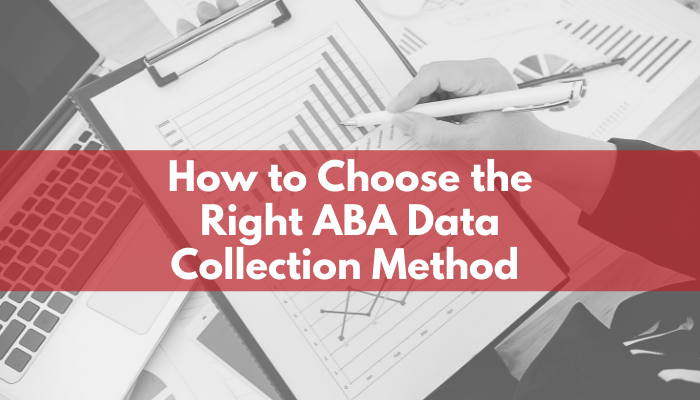
When creating programs in Applied Behavior Analysis it is important to consider which data collection method would be best suitable for your clients’ needs. Ask yourself which form of data collection will help yield the most accurate results? How often does the behavior occur? Are you trying to increase or decrease the behavior? And what method has the greatest social validity?

Duration
Duration data allows us to record how long a behavior occurs for. This is helpful for high-rate behaviors that have a distinct beginning and end. For example, some common behaviors you may see duration recording used for include tantrums, screaming, or out-of-seat behavior; however, this does not mean you have to utilize duration recording for these behaviors. While duration does have the advantage of recording the length of behavior, there is the potential disadvantage of not being able to record the total number of incidents within that episode. For instance, if you include hitting while screaming within your definition of a tantrum and only record it under duration, you are not collecting information about how many episodes of hitting are actually occurring. It would be valuable to know if the child is screaming for five minutes and engaged in hitting twenty times versus screaming for ten minutes and only hitting once.
Rate
Let’s look into rate data. Rate has the advantage of greater accuracy when you are tracking data across observations that may not be the same length of time. Imagine you are evaluating how often a client engages in property destruction, but on Mondays they have longer sessions. If you’re utilizing frequency and graphing how many instances of property destruction the client engages in per day, on the graph it may appear that there are significant increases in the behavior on Monday’s. However, in reality, the reason for the perceived increase is the longer sessions.
Frequency
If we see greater accuracy with rate as a form of data collection, why would we utilize frequency? Frequency is more commonly used than rate due to its convenience. Rate has the extra step of starting and stopping timers and then calculating the behavior divided by the time. There is typically a greater social validity with frequency because it is easier to collect data. For example, let’s say you are working with a caregiver to decrease the number of times their child exits their room in the middle of the night. It might be challenging for the caregiver to remember to track the exact time the child goes to bed and the exact time they wake up in the morning. Additionally, it’s likely that bedtime, on average, is around the same duration every night and that the difference wouldn’t matter to the caregiver if their child exits their room ten times in eight hours versus ten times in nine hours.

Interval Recording
With both rate and frequency, you need to track each occurrence of a behavior. However, sometimes that can be extremely difficult. Some behaviors may occur too frequently or be difficult to track a distinct beginning and end to count as individual occurrences. Also, sometimes it may not be the frequency that matters as much as how long the behavior occurs. For example, let’s say a client had one tantrum in an hour. A single instance of a ten-second tantrum in an hour looks a lot different than a ten-minute tantrum in an hour. So, what are your options when it’s too challenging to record each instance of a behavior? That’s when we consider interval recording.
Types of Interval Recording
With interval recording you record the presence of the behavior within the interval of your choosing, could be every ten seconds, every minute, every ten minutes, etc. Interval recording includes whole interval, partial interval, and momentary time sampling:
- Whole interval requires the behavior to occur throughout the entire interval to be counted as an occurrence.
- Partial interval requires the behavior to occur at any point throughout the interval to count as an occurrence.
- Then, momentary time sampling requires that the behavior occurs at the very end of the interval to count as an occurrence.
When is it a good idea to utilize interval recording? Imagine your client continuously engages in echolalia throughout their session; how challenging would it be for you to run programs and also count each individual occurrence of echolalia? For this reason, you would likely gravitate to a partial interval or momentary time sampling as a form of data collection. With partial interval recording, you would only need to observe the behavior once throughout the interval to count it as an occurrence. For momentary time sampling, you would only need to record the occurrence if the behavior was displayed at the end of the interval. This is a lot simpler than trying to count each individual occurrence, especially for teachers who have other students to attend to or caregivers who have other tasks to focus on throughout the day. It is nearly impossible for most individuals to observe and record continuously unless they are 1:1.
Collecting Data with Catalyst
How can I easily keep track of all my data? In the field, clickers are commonly used to collect frequency and rate data however they can become extremely bulky, difficult, and even hazardous to carry around. If you rely on paper data, you may need to bring a few different tools; a timer, multiple clickers for different frequency counts, papers, and a writing utensil. This can become super challenging to carry around and keep track of when you are in a session. Also, if you collect data this way, you eventually need to transfer and input it somewhere else to graph it. With Catalyst, you can collect all your data on your personal device and then the system will automatically graph your data. The Catalyst app has a timer for duration data, multiple tally buttons for frequency or rate data, and you can even take interval data. Additionally, you can take data on your targets and score the specific prompt you utilized when running that trial.
Final Thoughts

Tania Duarte, M.S. BCBA
Tania Duarte received her M.S. in Applied Behavior Analysis from Florida State University. She has over ten years of clinical experience working with individuals with disabilities in various settings, including schools, homes, clinics, and community settings. Additionally, she has worked with DataFinch's Customer Experience Team, assisting ABA practitioners with their data collection software needs. Tania currently serves as the eLearning M.A. Program Coordinator at ABA Technologies and works with students pursuing their masters in ABA at the Florida Institute of Technology.
References
- LeBlanc, L. A., Lund, C., Kooken, C., Lund, J. B., & Fisher, W. W. (2020). Procedures and accuracy of discontinuous measurement of problem behavior in common practice of applied behavior analysis. Behavior Analysis in Practice, 13(2), 411-420.
- Repp, A. C., Roberts, D. M., Slack, D. J., Repp, C. F., & Berkler, M. S. (1976). A comparison of frequency, interval, and time‐sampling methods of data collection. Journal of Applied Behavior Analysis, 9(4), 501-508.
This post is for informational purposes only and is not meant to be used in lieu of practitioners’ own due diligence, state and federal regulations, and funders’ policies.

